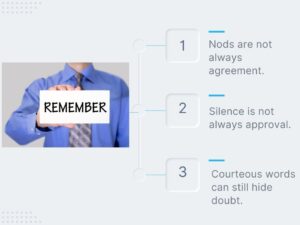Delivery Without Clarity Does Not Deliver
 Communication is not a side activity that supports the work; it is the work. Without it, even the best solutions struggle to be seen, understood and valued.
Communication is not a side activity that supports the work; it is the work. Without it, even the best solutions struggle to be seen, understood and valued.
I once heard a participant say: “I lost a client not because of what I delivered but because of what I failed to say clearly.”
In business, we assume that strong delivery ensures strong relationships. The truth is more fragile. Clients rarely walk away over one obvious mistake. More often they leave because of a series of subtle communication slips—each invisible at the time but together powerful enough to erode trust.
How does this happen and what we can do about it?
The Hidden Cost of “Almost Clear” Workplace Communication
There is a danger in being almost understood. Imagine telling a client that something will be ready “soon.” What does “soon” mean? Tomorrow? Next week? Or next quarter? To you, it may feel obvious. To the client, it may mean something very different.
“ Looks good” is another example. Does it mean the draft is approved, or only acceptable for now? When communication is 80 percent clear, it creates a false sense of certainty. And that is often worse than outright confusion, because no one realises the gap until it is too late.
Looks good” is another example. Does it mean the draft is approved, or only acceptable for now? When communication is 80 percent clear, it creates a false sense of certainty. And that is often worse than outright confusion, because no one realises the gap until it is too late.
A client we worked with recently shared an interesting piece of data. Their internal survey showed that vague instructions and unclear updates were costing employees 7.47 hours per week in unclear communication. That is an entire workday lost simply because “almost clear” is not clear enough.
The Illusion of Agreement
In Indian business settings, politeness sometimes hides disagreement. A client may nod during a presentation, not because they are aligned, but because challenging you directly feels uncomfortable. On the surface, everything looks fine. Underneath, doubt is growing.

This “illusion of agreement” is dangerous. You walk out thinking the project is secure, while the client quietly starts exploring other options. And then one day, without warning, the emails stop.
According to the Economist Intelligence Unit, 44 percent of employees believe poor organizational communication is the main reason for failed projects—which is often the endgame of that silent, unseen drift in understanding
Micro-Miscommunications That Snowball
It is rarely the “big fight” that ends a business relationship. More often, it is the small things: the email that sounded curt, the call where a point was missed, the update that felt incomplete.
These are like tiny cracks in a wall. Left unattended, they spread. Over time, what started as a small misunderstanding turns into what we might call communication debt. Just as technical debt slows down a system when quick fixes pile up, communication debt eats away at trust when unresolved slips accumulate.
 In early 2025, a collision occurred over Washington, D.C., between an American Airlines regional jet and a US Army Black Hawk helicopter. Investigators noted that fatigue and understaffed air traffic control stations meant roles were combined, and crucial radio transmissions were potentially missed or misheard. Pilots on both aircraft could receive the controller’s messages but were not listening to each other—setting the stage for tragedy. This micro-miscommunication, in a high-stakes environment, proved fatal.
In early 2025, a collision occurred over Washington, D.C., between an American Airlines regional jet and a US Army Black Hawk helicopter. Investigators noted that fatigue and understaffed air traffic control stations meant roles were combined, and crucial radio transmissions were potentially missed or misheard. Pilots on both aircraft could receive the controller’s messages but were not listening to each other—setting the stage for tragedy. This micro-miscommunication, in a high-stakes environment, proved fatal.
The Cost of Over-Explaining
Ironically, sometimes we lose clarity by trying too hard. Over-explaining is another silent killer of client trust.
Think about the times you have read a report so full of jargon and detail that the main message was buried. Or when someone spent twenty minutes defending a simple decision. Instead of building confidence, excessive talk can confuse, overwhelm and even frustrate the client.
Let’s say, you are part of a consulting team that has worked hard on a project update. The deck runs to 120 slides because you want to show the client everything you have done. When you present, you notice their eyes glaze over halfway through. By the end they thank you politely, but later you hear that they did not feel confident you understood the real issue. What you saw as being thorough, they experienced as noise.
When explaining, ask yourself:
- Am I adding clarity or just adding volume?
- Is the core message visible in the first 60 seconds?
- Will the client leave the discussion more confident or more drained?
The best communication is not the longest—it is the clearest.
Feedback Loops That Never Loop Back
 Effective client Communication is not complete when you send an update. It is complete when you confirm that it has been understood. Yet many businesses stop halfway. We share plans, ask for feedback and assume silence means agreement.
Effective client Communication is not complete when you send an update. It is complete when you confirm that it has been understood. Yet many businesses stop halfway. We share plans, ask for feedback and assume silence means agreement.
But silence is not confirmation. Closing the loop by asking questions, checking alignment, or summarising next steps prevents many painful surprises. This “closed-loop communication” is simple but often overlooked.
“In communication, silence is rarely golden.”
Customer success teams who proactively engage with clients, confirm their understanding and follow up, achieve higher revenue growth and higher gross margins
Cultural Fluency vs. Language Fluency
Being fluent in English does not mean being fluent in communication. A sentence delivered with the right words but the wrong tone can still offend or confuse.
Global clients, for instance, may value directness and brevity. Indian clients may prefer context and relationship-building before decision-making. Even metaphors matter—what resonates in New York may fall flat in Mumbai. Cultural fluency means tuning in not only to what is said, but how it is received.
The Silent Signals Clients Send Before Leaving
Clients rarely announce, “We are losing trust in you.” Instead, they send signals—delayed replies, vague feedback, less enthusiasm in meetings. These are not just scheduling issues. They are often communication red flags.
The tragedy is that by the time these signals are noticed, it is usually too late. The client has already emotionally checked out. Paying attention early can save the relationship.
Watch out for red flags like:
- Shorter and delayed responses.
- Less detailed feedback.
- Declining attendance in meetings.
- Reduced energy or engagement.
The ROI of Communication Training
For many companies, communication feels like a soft skill. Something nice to have, but not critical. The reality is the opposite. Strong communication reduces churn, shortens sales cycles and even boosts referrals.
One IT services firm invested in communication coaching for its client-facing teams. Within six months, they reported fewer project escalations, faster approvals and a measurable rise in repeat business. The return on investment was not abstract, it was written clearly in the numbers.
Why Communication Decides the Outcome
Talk may be cheap, but miscommunication is very expensive. Every missed word, vague timeline, or unspoken doubt carries a cost. The good news is that with awareness, practice, and the right training, these costs can be avoided.
In the end, communication is not about saying more. It is about making sure what is said is truly understood. And in business, that can be the difference between a lost client and a loyal partner.
If you want your teams to turn communication into a competitive edge, reach out to us at info@theyellowspot.com / India: +91 99677 14310, +91 87792 84314
Or Visit us on ‘https://www.theyellowspot.com’
#leadership skills # Customer Centricity # Effective Communication # corporate training # best corporate training companies # Time Management # Ownership & Accountability #softskillstraining





